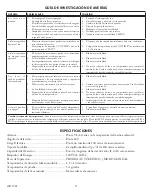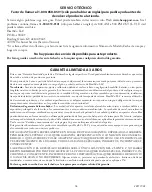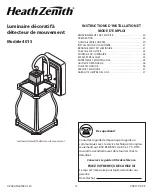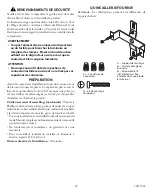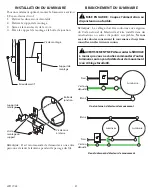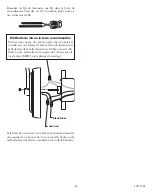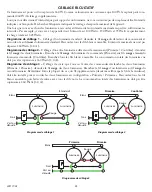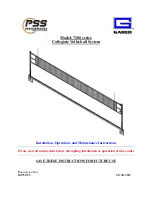
8
209177-03
SPECIFICATIONS
Range ................................................................Up to 30 ft. (9.1 m) [varies with surrounding temperature]
Sensing Angle....................................................Up to 180°
Electrical Load ..................................................Up to 100 Watt Maximum Incandescent
Bulb Type ..........................................................Medium Base, Type “A”, 100 Watt Maximum
Sensor Capacity .................................................Up to 360 Watt (3.0 A) Maximum Tungsten
Power Requirements ..........................................120 VAC, 60 Hz
Operating Modes ..............................................TEST, AUTO, and MANUAL MODE
ON-Timer .........................................................1, 5, 10 minutes
Test Timer .........................................................5 Seconds
Manual Mode Timer .........................................Dusk-to-Dawn
SYMPTOM
POSSIBLE CAUSE
SOLUTION
Lights will not
come on.
1. Light switch is turned off.
2. Light bulb is loose or burned out.
3. Fuse is blown or circuit breaker is turned off.
4. Daylight turn-off is in effect.
5. Sensor not detecting movement.
6. Incorrect circuit wiring, if this is a new installation.
7. The outside air temperature is close to the same as a person’s
body heat.
1. Turn light switch on.
2. Check bulb and replace if burned out.
3. Replace fuse or turn circuit breaker on.
4. Recheck after dark.
5. Adjust sensitivity control.
6. Verify wiring is correct.
7. Increase the “Sensitivity” setting.
Lights come on
in daylight.
1. The motion sensor may be installed in a relatively dark location.
2. The “ON-TIME” switch is in the “TEST” position.
1. The fixture is operating normally under these conditions.
2. Set the “ON-TIME” switch to the 1, 5, or 10 minute setting.
Lights come on
for no apparent
reason.
1. The motion sensor may be sensing small animals or automobile
traffic.
2. Sensitivity is set too high.
3. The outside temperature is much warmer or cooler than a
person’s body heat (summer or winter).
4. The light fixture is wired through a dimmer or timer.
1. Reduce sensitivity.
2. Reduce sensitivity.
3. Reduce sensitivity.
4. Do not use a dimmer or timer to control the light fixture. Replace
the dimmer or timer with a standard on/off wall switch.
Lights stay on
continuously.
1. The sensor may be picking up a heat source like an air vent,
dryer vent, or brightly painted, heat-reflective surface.
2. The motion sensor is in manual mode.
3. Sensitivity is set too high.
4. The light fixture is wired through a dimmer or timer.
5. The light fixture is on the same circuit as a motor, transformer,
or fluorescent bulb.
1. Reduce sensitivity.
2. Switch the motion sensor to auto. See
Manual mode
on page 7.
3. Reduce sensitivity.
4. Do not use a dimmer or timer to control the light fixture. Replace
the dimmer or timer with a standard on/off wall switch.
5. Install the light fixture on a circuit without motors, transformers,
or fluorescent bulbs.
Lights flash on
and off.
1. Light control is in the TEST mode and warming up.
2. Heat being reflected from other objects may be affecting the
sensor.
1. Flashing is normal under these conditions.
2. Reduce sensitivity.
Seasonal Temperature Changes –
The closer the surrounding temperature is to a person’s body heat, the less sensitive the sensor will appear. The greater
the temperature difference, the more sensitive the sensor will appear. The SENS control might need to be readjusted toward MIN or MAX as the outside
temperature changes for the different seasons. This is a normal part of the light sensor’s operation.
TROUBLESHOOTING GUIDE

















